

13+ Problem Solving Goals Speech Therapy
Our children and students are constantly having to navigate a different social situation all day long. That’s why teaching our students problem solving skills can be very beneficial. To help make your job as a Speech-Language Pathologist a little bit easier I’ve gone ahead and gathered over 13 problem solving goals for speech therapy.
Currently, with my 4-year-old twin boys, I am constantly working on how they can use their problem solving skills to come up with creative ways to solve their own problems.
Luckily as a speech therapist, I had training in teaching problem solving skills and love teaching them new strategies to try.
Right now my boys’ favorite way to problem solve is to say, “3 more minutes. You set a timer mommy.” The funny part is they don’t realize they could ask me for even more time (at least not yet!).

IEP Goals – Problem Solving Goals Speech Therapy
If you’re on the hunt for a long-term goal for problem solving here is our list of goals to add to your goal bank.
1. Given a problem and problem solving graphic organizer, STUDENT will identify 3 solutions, and the 3 consequences of those solutions, then determine the best solution and explain why that is the best solution with 80% accuracy in 4 out of 5 opportunities.
2. Given a problem, STUDENT will appropriately identify the size of the problem with 80% accuracy in 4 out of 5 opportunities.
3. Given problems at differing sizes, STUDENT will identify the appropriate reaction size to the problem with 80% accuracy in 4 out of 5 opportunities.
4. Given a real-life or role-play scenario, STUDENT will demonstrate how to accept teacher help to make an appropriate decision during a conflict situation with 80% accuracy in 4 out of 5 opportunities.
5. Given a real-life or role-play conflict scenario, STUDENT will demonstrate appropriate peer mediation skills to resolve the conflict with 80% accuracy in 4 out of 5 opportunities.
6. Given a real-life or role-play conflict scenario, STUDENT will remain calm and relaxed, listen to the other person, and determine what they can agree on with 80% accuracy in 4 out of 5 opportunities.
7. Given criticism or feedback, STUDENT will look at the person, say “okay”, and not argue with 80% accuracy in 4 out of 5 opportunities.
8. Given a problem, STUDENT will define exactly what the problem is, brainstorm possible options, consider the disadvantages and advantages of options, and choose the best option with 80% accuracy in 4 out of 5 opportunities.
9. Given a defeat or loss in a game, STUDENT will look at the person who won , remain calm, and congratulate the other person with 80% accuracy in 4 out of 5 opportunities.
10. Given an upsetting situation, STUDENT will express HIS/HER anger with non-aggressive words to describe how HE/SHE feels with 80% accuracy in 4 out of 5 opportunities.
11. Given a time when the student is angry, STUDENT will use a calming strategy (e.g., breathe slowly, take a break, count to 10, listen to music, etc.) with 80% accuracy in 4 out of 5 opportunities.
12. Given a warning and a change in routine, STUDENT will identify exactly what is changing, ask questions, remain calm, and explain HIS/HER feelings of concern with 80% accuracy in 4 out of 5 opportunities.
13. Given a warning and a change in routine, STUDENT will accept the change without becoming upset with 80% accuracy in 4 out of 5 opportunities.
14. Given a social interaction, STUDENT will identify HIS/HER emotion and why HE/SHE is feeling that way with 80% accuracy in 4 out of 5 opportunities.
Social Communication Skills – IEP Goals
Do you have students working on other social skills goals or language skills? If so, you might want to check out my other goal banks. Here are a few of the goals you would find in my massive 432 iep goal bank :
- Facial expressions
- Conversational exchange or conversational turns
- Body language
- Follow-up questions
- Expressive Language
- Wh questions or Answer questions
- Word Level, Phrase Level, and Sentence Level
- Social pragmatic goals
- Communication Device – Nonverbal communication
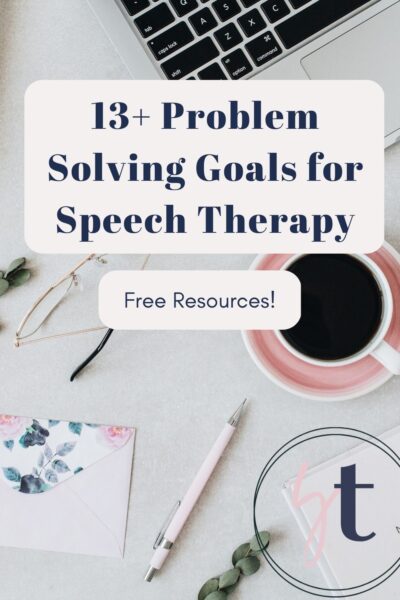
Short-Term Goals – Speech Therapy Goals
I know every district and even school setting has different ways it requires the goal writing of their objectives to be written, but typically my district wanted us to reduce either the number required or the percentage of achievement.
Here are a few examples to help get you started.
If we take a sample goal:
“Given a problem and problem solving graphic organizer, STUDENT will identify 3 solutions, the 3 consequences of those solutions, then determine the best solution, and explain why that is the best solution with 80% accuracy over 3 out of 4 consecutive sessions.”
- Reduced Number or Trials Required: The objective might be, “Given a problem and problem solving graphic organizer, STUDENT will identify 2 solutions, the 2 consequences of those solutions, then determine the best solution, and explain why that is the best solution with 80% accuracy over 3 out of 4 consecutive sessions.”
- Reduce Percentage of Accuracy: The objective might be, “Given a problem and problem solving graphic organizer, STUDENT will identify 3 solutions, the 3 consequences of those solutions, then determine the best solution, and explain why that is the best solution with 70% accuracy over 3 out of 4 consecutive sessions.”
- Reduce Difficulty of Task: The objective might be, “Given a problem and problem solving graphic organizer, STUDENT will pick from a selection of choices 2 possible solutions, the 2 possible consequences of those solutions, then determine the best solution, and explain why that is the best solution with 80% accuracy over 3 out of 4 consecutive sessions.”
- Reduce Number of Sessions of Accuracy: The objective might be, “Given a problem and problem solving graphic organizer, STUDENT will identify 3 solutions, the 3 consequences of those solutions, then determine the best solution, and explain why that is the best solution with 80% accuracy over 2 out of 4 consecutive sessions.”
(Meaning out of 4 therapy sessions in a row. They identified 3 possible solutions, the 3 consequences of those solutions and then determined the best solution in 2 out of 4 or 50% of the time in order to mark that goal mastered.)
As the speech pathologist, you are the specialist and you know your students’ communication disorders and child’s ability best though, so just take the functional goals from above and simplify them into achievable steps for your specific student.
SEE ALSO: 31 Best Wordless Videos to Teach Problem Solving
Data collections – problem solving goals speech therapy.
If you’re a speech therapist or have classroom teachers in need of data tracking forms while working on your student’s social interaction skills for speech therapy then be sure to check out my IEP goal data tracking for progress monitoring forms .
Or if you simply want a list of data sheets to choose from then be sure to check out my list of 35 free speech therapy data sheets roundup .

Visual Cue – Problem Solving Goals Speech Therapy
I always love using visual cues with my students. It can really help teach a concept that can be overwhelming.
Here is my problem solving graphic organizer that helps teach problem solving. As your child or student fills out the form you can start by providing helpful verbal prompts and hopefully, the more they work on their problem solving skills and will need less prompts.
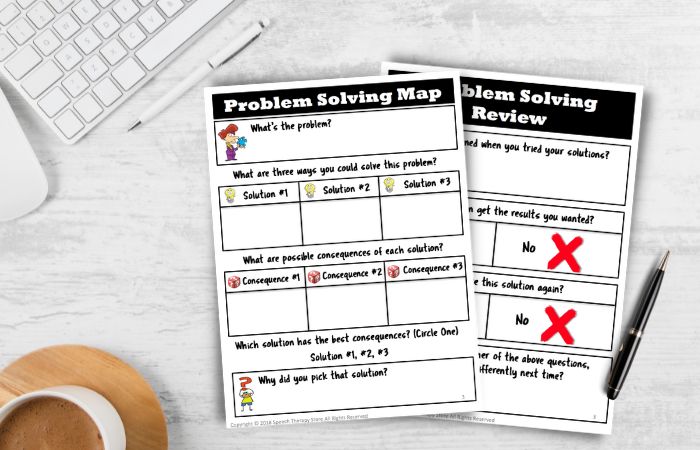
Here are all my blog posts about problem solving that you might also find helpful!
31 Best Wordless Videos to Teach Problem Solving – Watch the fun short youtube videos and then help solve the hypothetical problems.
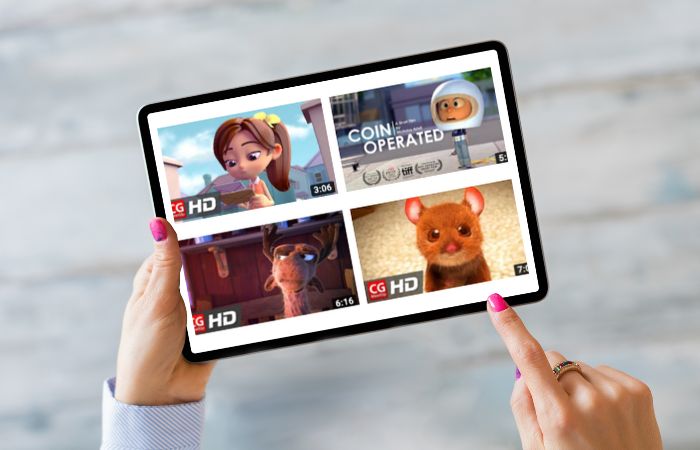
71+ Free Social Problem-Solving Scenarios – Read the scenarios and practice solving the problems using the helpful graphic organizer pages.

Problem Solving Wheel: Help Kids Solve Their Own Problems – Use our problem solving wheel or make your own individualized problem solving wheel for your specific student.
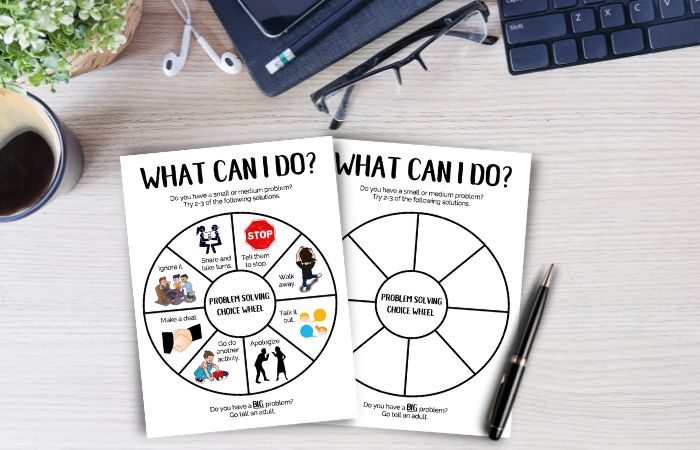
High School Students
The most important thing we can teach our high school aged students is how to advocate for themselves during their school day within a social setting.
Inside my tpt store I have a self-advocacy lesson to practice solving their school life problems in a functional way. Have your students grab a communication partner and get started!

In addition to the self-advocacy lesson plan I also have a phone call lesson plan in my tpt store for making phone calls in the workplace or everyday life, such as calling the pharmacy or dentist’s office.


SEE ALSO: 71+ Free Social Problem-Solving Scenarios
Younger children.
Currently inside of my tpt store I have a problem size and reaction size lesson plan to help our younger children understand that problems are of different sizes and therefore different reaction sizes.
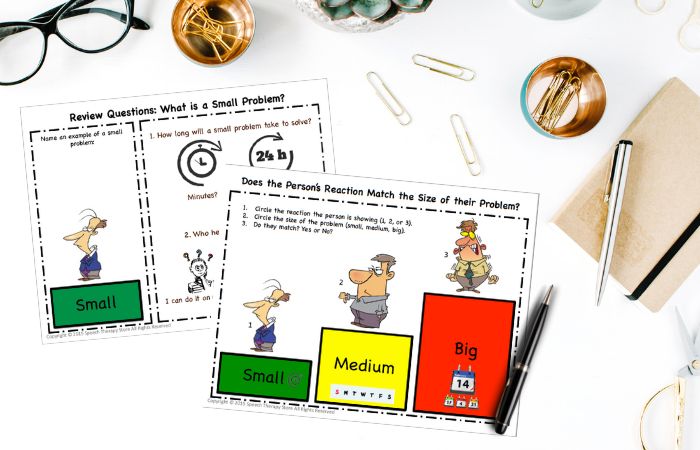
Another great problem solving resource in my tpt store is my problem solving restorative justice graphic visual to help children review their own feeling along with how the other person might have felt and then solve their problem.
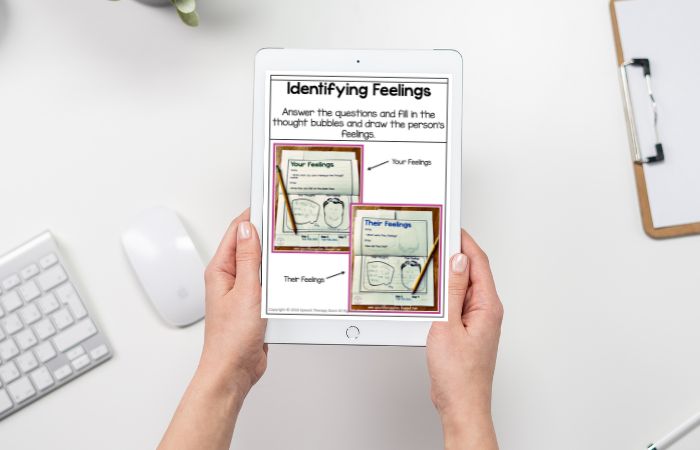
Picture Scene
- Social Scene Set 1 , Set 2 , Set 3 , Set 4 , Set 5 , & Set 6 by Contrary Chrissy – are different social scenes along with questions for problem solving.
- Back to School Social Language and Problem Solving Printable by Aimee Walton – includes different scenarios along with questions to help guide the student in solving the problem.
SEE ALSO: Problem Solving Wheel: Help Kids Solve Their Own Problems
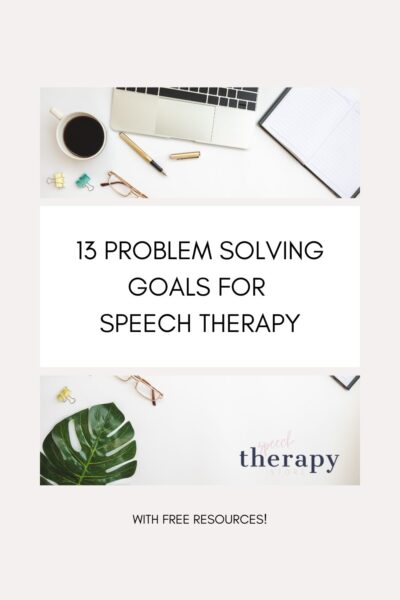
Social Conversation
If you’re looking for conversational skills to keep your middle school and high school aged students engaged, asking follow-up questions, or working on generalizing their skills across multiple settings you’ll want to check out the following blog posts.
These ideas are perfect for working in a small group setting on your student’s functional communication skills.
- Ideas to Help Keep Your Middle/High School Students Engaged – This post reviews 5 different strategies you can use to help keep your students engaged, such as using real life photos instead of little kid graphics and using materials at different levels allowing everyone to access the resources at their individual level.
- Ideas to Maintain a Conversation with Follow-Up Questions – Read how I help middle/high school students work on their social pragmatics of maintaining a conversation by using fun and interesting materials appropriate for their age.
- Ideas to Help Students Generalize Their Conversational Skills – Learn how I use self-rating forms to work on my student’s pragmatic language goals of generalizing their conversational skills across multiple settings and with multiple different people.
Short Story
- Inferencing and Problem-Solving FREEBIE by SLP to go – This resource is perfect for older students who are working on any of the following skills: inferencing, problem-solving, predicting, role-playing, or maintaining a conversation.
- Social Skills Problem Solving: Fighting with Friends by Let’s Build Language- Jaclyn Watson – Grab this freebie to help your students problem solve social challenges around fighting with friends.
In Conclusion: Problem Solving Goals Speech Therapy
I hope you found this list of problem solving goals to be helpful along with the resources.
Wishing you a wonderful year ahead!
Want Even More Problem Solving Goals Speech Therapy?
- 31 Best Wordless Videos to Teach Problem Solving
- 71+ Free Social Problem-Solving Scenarios
- Problem Solving Wheel: Help Kids Solve Their Own Problems
- 917+ Best Free Boom Cards for Speech Therapy
- 432+ Free Measurable IEP Goals and Objectives Bank
Want the Best of the Bests?
Be sure to check out our most popular posts below!
- 21 Best Reinforcement Games for Speech Therapy / Teletherapy
- Best IEP Resources
- 430+ Free Multisyllabic Words List Activity Bundle
- 279+ Free Speech Therapy Digital Materials
- 179+ Free Speech Therapy Wh-Questions Printable

IMAGES
VIDEO